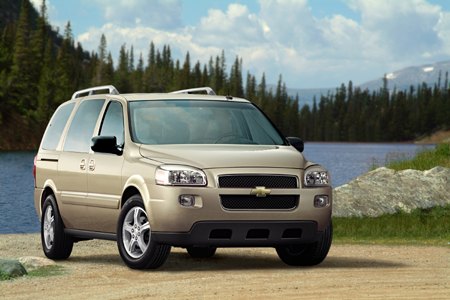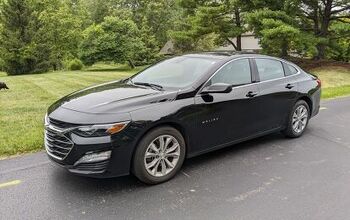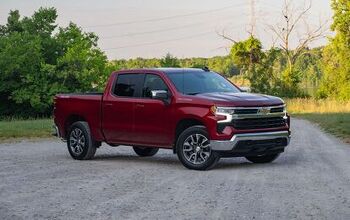Chevrolet Uplander Review
An airport car rental attendant recently handed me the keys to my temporary chariot and declared “Your car is down the row to your right. It’s an ‘06 Uplander.” A what? “It’s kind of an SUV,” she kind of explained. The butt-end of a something large and ugly poked out of stall 97. The bow tie on the trim above the license plate revealed the vehicle’s manufacturer: Chevrolet. Apprehensively, I slid behind the wheel of the awkward-looking beast. I looked around. I turned to my colleague. “No wonder GM is in such bad shape.”
The Uplander’s exterior could have been penned twenty-five years ago. The awkward yet infinitely bland exterior displays all the styling finesse and surface excitement of a 1981 Chevy Malibu– with none of the stalwart sedan’s balanced proportions. You can see how GM’s designers tried to transform their plane Jane minivan into a “Crossover Sport Van”: a longer than needed snout, big-ass B-pillars, slightly larger wheels and faux skid plates. It’s an entirely unconvincing effort that somehow manages to capture the worst of both the SUV and minivan genres.
Once inside, a flip-down DVD screen attached to ceiling rails provides the only indication that “Bette Davis Eyes” isn’t about to debut on the radio. Again, it’s an interior from another era– before Chrysler, Honda and Toyota showed American soccer Moms that you could schlep the team in something very much approaching style. Hell, you can’t even get comfortable in the thing. The Uplander’s driver’s seat wouldn’t retreat far enough to accommodate my frame, and my preferred steering wheel position fell somewhere between two notches. Hello? I’m 5’11”.
Otherwise, the comfort sucks. The Uplander’s architecture, inherited from the 1997 Chevrolet Venture (whose running gear lives in perpetuity) is still too narrow to accommodate its [theoretical] complement of seven adults. And the Uplander’s plastics seem designed by rental car companies for rental car companies; their ability to withstand endless applications of industrial strength ammonia being their only saving grace.
Needless to say, the Uplander is as dreadful to drive as it is to inhabit. The loose steering requires constant tending at anything other than a dead stop. The suspension crashes more often than a demolition derby driver. The long wheelbase and epic turning circle make parking lot maneuvering a seemingly endless chore. It leans excessively in corners. But wait! There’s less!
The CSV’s 3.9-liter V6 pushrod powerplant boasts (in the ironic sense of the word) a cast iron block with cast aluminum heads, hooked-up to Ye Olde Four Speed. With constant aural reminders that it would much rather be switched off, the ancient, rough-revving mill delivers a class-leading 240hp @ 6000rpm. But it's not enough to motivate the ponderous beast into a jog. In short, the Uplander’s performance doesn’t even deserve the noun.
To GM’s credit, the Uplander completed its assigned task: transporting my colleague and me safely from airport to office, office to hotel and back. The vehicle’s lights, windshield wipers and turn signals worked. There was plenty of cargo room. The engine made the thing move forward and the brakes brought it to a stop. I observed no sharp objects that might threaten to cut or maim passengers. But all of this was done with Soviet-repressed bureaucratic adequacy.
If you doubt that the Uplander is a half-assed has-been that never was and never shoulda been, click on this link from the Uplander’s menu and select Braking, Engine and Transmission. Three years after the model’s debut and the information is still “Not yet published.” In terms of design, refinement and packaging, competitive minivans (yes, minivans) from Honda, Toyota and Chrysler are literally decades ahead of the Uplander. And proud of it.
How could a thing such as an Uplander come to be? Hundreds of GM employees spent years on its development and implementation: designers, engineers, marketers and senior management. Ultimately, all of them stamped their approval on the Uplander and proclaimed to the world THIS IS OUR BEST IDEA. If fact, the company as a whole considered the concept so inspired they felt compelled to badge engineer this execrable automotive aardvark as the Saturn Relay, Buick Terraza and Pontiac Montana.
The General has hit some home runs with a couple of products lately (e.g. the Corvette and the Pontiac Solstice / Saturn Sky). Cadillac is heading in the right direction. But these are niche vehicles, not machines for the masses. To recover from its well-documented woes, GM needs volume sales of mainstream products. Otherwise, they’re heading straight for bankruptcy. But if bankruptcy is the only way to stop GM from inflicting crap vehicles like the Uplander on unsuspecting rental car drivers and (God forbid) buyers, then I can’t help but wish the world’s largest automaker a speedy Chapter 11.
More by William C Montgomery
Latest Car Reviews
Read moreLatest Product Reviews
Read moreRecent Comments
- Pau65792686 I think there is a need for more sedans. Some people would rather drive a car over SUV’s or CUV’s. If Honda and Toyota can do it why not American brands. We need more affordable sedans.
- Tassos Obsolete relic is NOT a used car.It might have attracted some buyers in ITS DAY, 1985, 40 years ago, but NOT today, unless you are a damned fool.
- Stan Reither Jr. Part throttle efficiency was mentioned earlier in a postThis type of reciprocating engine opens the door to achieve(slightly) variable stroke which would provide variable mechanical compression ratio adjustments for high vacuum (light load) or boost(power) conditions IMO
- Joe65688619 Keep in mind some of these suppliers are not just supplying parts, but assembled components (easy example is transmissions). But there are far more, and the more they are electronically connected and integrated with rest of the platform the more complex to design, engineer, and manufacture. Most contract manufacturers don't make a lot of money in the design and engineering space because their customers to that. Commodity components can be sourced anywhere, but there are only a handful of contract manufacturers (usually diversified companies that build all kinds of stuff for other brands) can engineer and build the more complex components, especially with electronics. Every single new car I've purchased in the last few years has had some sort of electronic component issue: Infinti (battery drain caused by software bug and poorly grounded wires), Acura (radio hiss, pops, burps, dash and infotainment screens occasionally throw errors and the ignition must be killed to reboot them, voice nav, whether using the car's system or CarPlay can't seem to make up its mind as to which speakers to use and how loud, even using the same app on the same trip - I almost jumped in my seat once), GMC drivetrain EMF causing a whine in the speakers that even when "off" that phased with engine RPM), Nissan (didn't have issues until 120K miles, but occassionally blew fuses for interior components - likely not a manufacturing defect other than a short developed somewhere, but on a high-mileage car that was mechanically sound was too expensive to fix (a lot of trial and error and tracing connections = labor costs). What I suspect will happen is that only the largest commodity suppliers that can really leverage their supply chain will remain, and for the more complex components (think bumper assemblies or the electronics for them supporting all kinds of sensors) will likley consolidate to a handful of manufacturers who may eventually specialize in what they produce. This is part of the reason why seemingly minor crashes cost so much - an auto brand does nst have the parts on hand to replace an integrated sensor , nor the expertice as they never built them, but bought them). And their suppliers, in attempt to cut costs, build them in way that is cheap to manufacture (not necessarily poorly bulit) but difficult to replace without swapping entire assemblies or units).I've love to see an article on repair costs and how those are impacting insurance rates. You almost need gap insurance now because of how quickly cars depreciate yet remain expensive to fix (orders more to originally build, in some cases). No way I would buy a CyberTruck - don't want one, but if I did, this would stop me. And it's not just EVs.
- Joe65688619 I agree there should be more sedans, but recognize the trend. There's still a market for performance oriented-drivers. IMHO a low budget sedan will always be outsold by a low budget SUV. But a sports sedan, or a well executed mid-level sedan (the Accord and Camry) work. Smaller market for large sedans except I think for an older population. What I'm hoping to see is some consolidation across brands - the TLX for example is not selling well, but if it was offered only in the up-level configurations it would not be competing with it's Honda sibling. I know that makes the market smaller and niche, but that was the original purpose of the "luxury" brands - badge-engineering an existing platform at a relatively lower cost than a different car and sell it with a higher margin for buyers willing and able to pay for them. Also creates some "brand cachet." But smart buyers know that simple badging and slightly better interiors are usually not worth the cost. Put the innovative tech in the higher-end brands first, differentiate they drivetrain so it's "better" (the RDX sells well for Acura, same motor and tranmission, added turbo which makes a notable difference compared to the CRV). The sedan in many Western European countries is the "family car" as opposed to micro and compact crossovers (which still sell big, but can usually seat no more than a compact sedan).





































Comments
Join the conversation
Here, here, Sassy. I just bought a 2007 for a couple bucks and am thrilled to get a reliable workhorse like the uplander. These effete car snobs and their "OMG! It's so ugly! Outre! How could anyone possibly buy one?" Basically it gets you where you wanna go, hauls your peeps and stuff, and doesn't cost much.
Cope